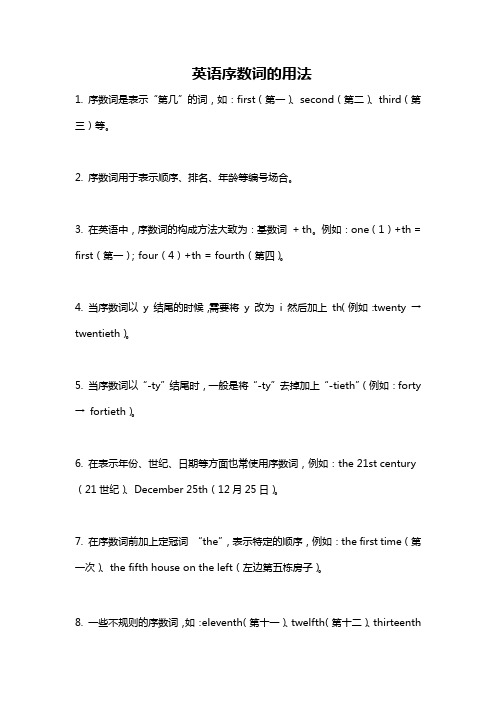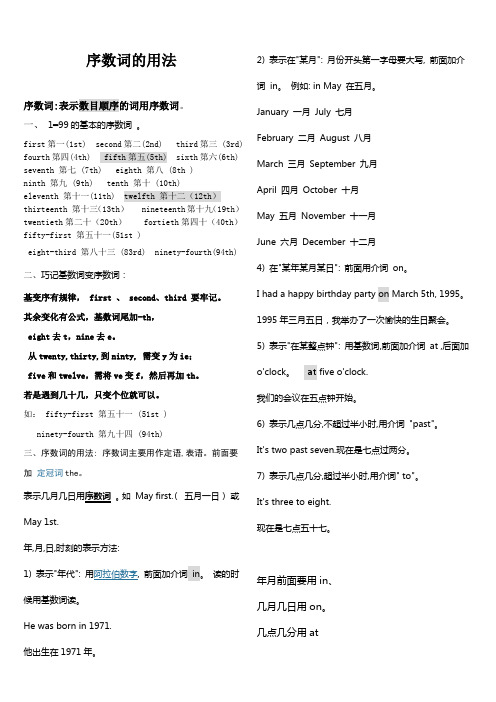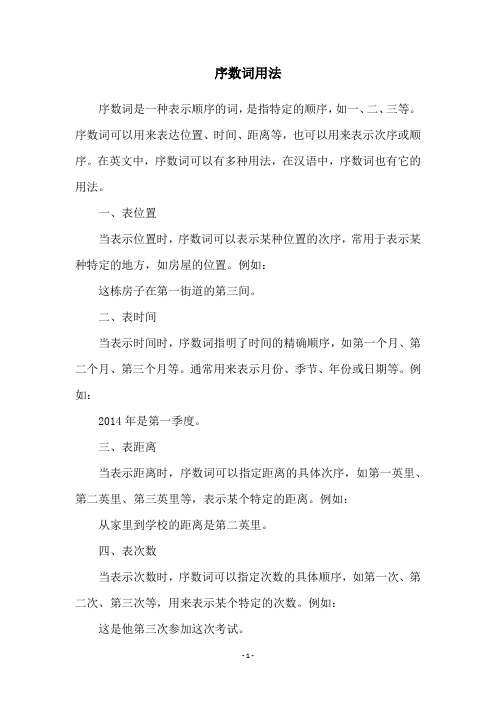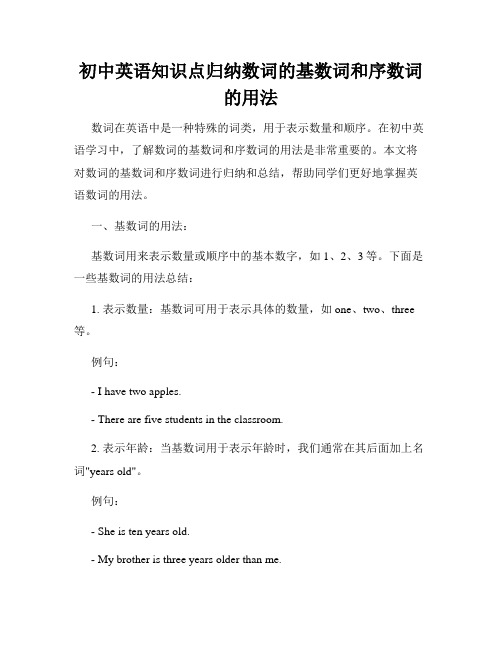序数词的用法总结
序数词的用法

2. 序数词表示顺序的词称为序数词。
序数词的主要形式:A.从第一至第十九其中,one— first,two— second,three— third,five— fifth,eight—eighth,nine—ninth,twelve— twelfth为特殊形式,其它的序数词都是由其相对应的基数词后面添加“th”构成。
例如:six— sixth、nineteen— nineteenth.B.从第二十至第九十九整数第几十的形式由其对应的基数词改变结尾字母y为i,再加“eth”构成。
twenty——twentieth thirty——thirtieth表示第几十几时,用几十的基数词形式加上连字符“-”和个位序数词形式一起表示。
thirty-first 第三十一fifty-sixth 第五十六seventy-third 第七十三ninety-ninth 第九十九C.第一百以上的多位序数词由基数词的形式变结尾部分为序数词形式来表示。
one hundred and twenty-first 第一百二十一one thousand,three hundred and twentieth 第一千三百二十D.序数词的缩写形式有时,序数词可以用缩写形式来表示。
主要缩写形式有。
first——lst second——2nd third——3rdfourth——4th sixth——6th twentieth——20thtwenty-third——23rd其中lst,2nd,3rd为特殊形式,其它的都是阿拉伯数字后加上th。
E.序数词的句法功能序数词在句中可作主语、宾语、定语和表语。
The second is what I really need.第二个是我真正需要的。
(作主语)He choose the second.他挑选了第二个。
(作宾语)We are to carry out the first plan.我们将执行第一个计划。
英语序数词的用法

英语序数词的用法
1. 序数词是表示“第几”的词,如:first(第一)、second(第二)、third(第三)等。
2. 序数词用于表示顺序、排名、年龄等编号场合。
3. 在英语中,序数词的构成方法大致为:基数词+ th。
例如:one(1)+th = first(第一);four(4)+th = fourth(第四)。
4. 当序数词以y 结尾的时候,需要将y 改为i 然后加上th(例如:twenty →twentieth)。
5. 当序数词以“-ty”结尾时,一般是将“-ty”去掉加上“-tieth”(例如:forty →fortieth)。
6. 在表示年份、世纪、日期等方面也常使用序数词,例如:the 21st century (21世纪)、December 25th(12月25日)。
7. 在序数词前加上定冠词“the”,表示特定的顺序,例如:the first time(第一次)、the fifth house on the left(左边第五栋房子)。
8. 一些不规则的序数词,如:eleventh(第十一)、twelfth(第十二)、thirteenth
(第十三)、fifteenth(第十五)、eighteenth(第十八)等。
七年级序数词知识点

七年级序数词知识点序数词是表示事物顺序的词语,是数词的一种。
七年级的学生需要掌握序数词并正确地使用它们。
下面是七年级序数词的知识点。
一、基本概念序数词是描述事物顺序的词语,如“第一”、“第二”、“第三”等。
它们是由基数词加上后缀“-th”构成的,例如“one”变成“first”、“two”变成“second”、“three”变成“third”。
序数词通常用来表示排名、顺序和次序。
二、读法1. -th后缀读法- 表示序数的后缀-th通常是这样读的:从基数词的最后一个字母开始,读出该字母发音之前的所有字母,再加上th。
例如:two → secondfive → fifthtwelve → twelfth2. 特殊读法- 以下基数词有一些规律变化:one → firsttwo → secondthree → thirdfive → fiftheight → eighthnine → ninthtwelve → twelfth- 但还有一些基数词的序数词读法不规则,需要记住:four → fourthsix → sixthseven → seventhten → tentheleven → eleventh三、用法1. 表示顺序序数词可以表示一些事物在一系列中的顺序,比如:排队、竞赛、年级等。
例如:My brother came in second in the race.She is the third student from the front row.2. 表示日期序数词也可以表示日期,例如:Today is August 20th.My birthday is on the first of January.3. 表示年龄需要用序数词来描述年龄时,例如:I am thirteen years old.(注意此处应当用old,而不是years old)四、注意事项1. 序数词前要加定冠词the,除非在口语中使用。
序数词的应用

序数词的应用序数词是表示顺序的词语,常常用来描述事物按照次序排列的情况。
它在日常生活中的应用非常广泛,无论是书写、口语交流还是阅读理解,都需要正确运用序数词。
下面将从书写、口语和阅读理解三个方面详细讨论序数词的应用。
一、书写在书写上,序数词通常用阿拉伯数字和英文表示,在不同语言环境中也有些许差异。
首先是阿拉伯数字的使用,比如“1st”表示“第一”,“4th”表示“第四”。
此外,在正式的书写场合中,序数词通常需要添加相应的后缀,如下所示:- 在一般情况下,以数字1结尾的序数词通常加上"st"后缀,例如:21st(第二十一)。
- 以数字2结尾的序数词通常加上"nd"后缀,例如:32nd(第三十二)。
- 以数字3结尾的序数词通常加上"rd"后缀,例如:43rd(第四十三)。
- 其他以数字0、4、5、6、7、8、9结尾的序数词通常加上"th"后缀,例如:10th(第十),56th(第五十六)。
需要注意的是,在日期的书写中,只需在数字后面直接加上相应的后缀,如“March 1st, 2022”表示“2022年3月1日”。
二、口语在口语中,序数词也是一种常见的表达方式。
比如在介绍自己的职位时,可以说"I am the first student in my class"(我是班里的第一名学生);在描述比赛名次时,可以说"She finished third in the race"(她在比赛中获得第三名)。
此外,在日常对话中,序数词也常用于表达日期、年龄、顺序等。
例如,我们可以说"Today is March 30th"(今天是3月30日)或"I'm the fifth person in line"(我是排队的第五个人)。
三、阅读理解阅读理解中对于序数词的应用主要是理解和运用上下文的信息。
序数词在句子中的作用及用法

序数词在句子中的作用及用法
序数词是一个表示顺序的词语,如:第一、第二、第三等。
在句子中,序数词可以发挥不同的作用,具体如下:
1. 表示顺序
序数词最基本的作用就是表示事物的排列顺序,如:
- 我们班上第一名是小明。
- 今天是十月十日,也就是双十节。
- 饭店位于市中心的第三十层,景色非常优美。
2. 表示次数
有时序数词也可表示次数,如:
- 这已经是他第三次迟到了。
- 我已经买了第六张门票了。
3. 表示阶段
序数词也可以表示某一阶段或某一段时间,如:
- 塔楼建成了第五层。
- 明年是我们结婚的第十年。
序数词使用的注意事项:
1. 序数词一般都用阿拉伯数字表示。
2. 序数词可以和量词连用,如:第三节课、第十五次机会等。
3. 序数词在句子中可以作状语,也可以作定语。
4. 数字中的“一”和“二”在写作序数词时,可以省略“一”和“二”
前的“第”,但在口语中不可省略,比如:“我是第三名”和“我是三名”是正确的,但口语中只能说“我是第三名”。
总而言之,序数词是很常见的一种词性,掌握好序数词的使用方法,不仅可以表达事物的排列顺序,还能使句子更加准确清晰。
序数词的用法

2. 序数词表示顺序的词称为序数词。
序数词的主要形式:A.从第一至第十九其中,one— first,two— second,three— third,five— fifth,eight—eighth,nine—ninth,twelve— twelfth为特殊形式,其它的序数词都是由其相对应的基数词后面添加“th”构成。
例如:six— sixth、nineteen— nineteenth.B.从第二十至第九十九整数第几十的形式由其对应的基数词改变结尾字母y为i,再加“eth”构成。
twenty——twentieth thirty——thirtieth表示第几十几时,用几十的基数词形式加上连字符“-”和个位序数词形式一起表示。
thirty-first 第三十一fifty-sixth 第五十六seventy-third 第七十三ninety-ninth 第九十九C.第一百以上的多位序数词由基数词的形式变结尾部分为序数词形式来表示。
one hundred and twenty-first 第一百二十一one thousand,three hundred and twentieth 第一千三百二十D.序数词的缩写形式有时,序数词可以用缩写形式来表示。
主要缩写形式有。
first——lst second——2nd third——3rdfourth——4th sixth——6th twentieth——20thtwenty-third——23rd其中lst,2nd,3rd为特殊形式,其它的都是阿拉伯数字后加上th。
E.序数词的句法功能序数词在句中可作主语、宾语、定语和表语。
The second is what I really need.第二个是我真正需要的。
(作主语)He choose the second.他挑选了第二个。
(作宾语)We are to carry out the first plan.我们将执行第一个计划。
序数词讲解

序数词讲解序数词讲解 1.基数词变序数词可利用口诀巧记:“一、二、三,特殊记,八去“t ” 九去“e”,“ve”要用“f”替,见“y”变成“i”和“e”,词尾加上“th”,若是遇到几十几,只变个位就可以。
” 变法first,second,third,eight—eighth nine—ninth,five—fifth,twelve—twelfth,twen- ty—twentieth,forty—fortieth,twenty-five—twenty-fifth。
2.其余情况均在基数词后加th。
如:six—sixth, nineteen—nineteenth , hundred— hundredth, thousand—thousandth等。
3. 序数词可以用作主语,宾语,表语,定语,同位语或状语。
如: The first of October is our National Day. 10月1日是我们的国庆节。
(the first)作主语。
At first she was asleep. 起先她还在睡觉。
(first 做介词at的宾语) She was first in the queue. 她排第一。
(first作表语) This is our first lesson. 这是我们的第一课堂。
(first作定语) Who is that man, the first in the front row? 前排第一个人是谁?(the first 作that man的同位语) But I must ask my parents first. 但是必须先问一下我的父母亲。
(first作状语) 4. 序数词前常用定冠词the, 表“顺序”。
但如果序数词不表示顺序,而表示“又一个,另一个”时,则不能用the, 要用a. Then they had a second child—a son. 后来他们又生了一个孩子—一个男孩。
英语中序数词的用法总结

英语中序数词的用法总结
英语上数词分为两大类:基数词和序数词,简单理解序数词是指表示顺序的数词。
除了表示顺序,在表示日期和分数时也经常会用到序数词。
序数词在句中可作主语、宾语、定语和表语。
扩展资料
序数词的.语法知识点
在英语中,使用序数词时前面要加定冠词the,但是,在下面的情况下则不加 the:
1、当序数词前有形容词性物主代词或名词所有格修饰时,序数词前不用 the。
2、当表达分数时,序数词前不用the。
3、当表达“又一,再一”时,序数词前不用the,但可加不定冠词。
4、当表达“年月日”时,序数词前不用the。
5、当序数词在句中作状语时,序数词前不用 the。
6、当表达比赛中获得的名次时,序数词前不用 the。
7、当表示某人的多少岁生日时,序数词前不加the。
小学序数词的用法

序数词的用法序数词:表示数目顺序的词用序数词。
一、 1━99的基本的序数词 。
first 第一(1st) second 第二(2nd) third 第三 (3rd) fourth 第四(4th) fifth 第五(5th) sixth 第六(6th)seventh 第七 (7th) eighth 第八 (8th ) ninth 第九 (9th) tenth 第十 (10th)eleventh 第十一(11th) twelfth 第十二(12th ) thirteenth 第十三(13th ) nineteenth 第十九(19th )twentieth 第二十(20th ) fortieth 第四十(40th ) fifty-first 第五十一(51st )eight-third 第八十三 (83rd) ninety-fourth(94th) 二、巧记基数词变序数词:基变序有规律, first 、 second 、third 要牢记。
其余变化有公式,基数词尾加-th , eight 去t ,nine 去e 。
从twenty,thirty,到ninty, 需变y 为ie ; five 和twelve ,需将ve 变f ,然后再加th 。
若是遇到几十几,只变个位就可以。
如: fifty-first 第五十一 (51st ) ninety-fourth 第九十四 (94th)三、序数词的用法: 序数词主要用作定语,表语。
前面要加 定冠词the 。
表示几月几日用序数词 。
如 May first.( 五月一日) 或 May 1st.年,月,日,时刻的表示方法:1) 表示"年代": 用阿拉伯数字, 前面加介词 in 。
读的时候用基数词读。
He was born in 1971. 他出生在1971年。
2) 表示在"某月": 月份开头第一字母要大写, 前面加介词 in 。
英语序数词的用法总结_概述及解释说明

英语序数词的用法总结概述及解释说明1. 引言1.1 概述英语序数词是用来表示顺序或排列顺序的数字,例如"first"(第一)、"second"(第二)等。
在英语中,序数词被广泛应用于各个领域,包括日期、时间、排名、学术写作等。
掌握好英语序数词的正确用法对于学习和运用英语具有重要意义。
1.2 文章结构本文将详细介绍英语序数词的基本用法、特殊情况下的用法以及高级应用和扩展知识点。
首先,我们将解释序数词的定义和概念,在此基础上说明其形式变化规则和基本使用注意事项。
接着,我们将探讨在日期表示和顺序表示中的特殊用法,并逐一比较序数词与基数词之间的区别和应用场景。
随后,我们将深入研究序数词在学术写作中的应用技巧以及常见英语习语中的使用场景解析。
最后,我们还将分享一些关于数字加序数词表达特定含义时的技巧以及常见误区分析。
1.3 目的本文旨在全面总结和解释英语序数词的用法,使读者能够深入了解和掌握序数词的基本概念和用法规则,并在实际应用中正确运用。
通过对特殊情况下的使用和扩展知识点的介绍,读者将能够更加灵活地运用序数词,并避免常见错误。
此外,本文还旨在为学术写作以及理解英语习语提供一些有益的指导和启示。
希望本文对于英语学习者和使用者有所帮助,并增强其对于英语序数词的理解与运用能力。
2. 英语序数词的基本用法:2.1 序数词的定义和概念:序数词是表示顺序或次序的词语,在英语中通常以数字后面加上后缀来构成。
它们用于描述事物在一系列中的位置。
2.2 序数词的形式变化规则:在大部分情况下,英语序数词可以通过在基数词(表示数量的数字)后面加上合适的后缀来形成。
例如,“one”这个基数词可以变成“first”,“two”可以变成“second”,“three”可以变成“third”,以此类推。
注意以下几个特殊情况:- 当基数词以“-y”结尾时,将其改为“-i”再加上“-eth”,例如:twenty →twentieth。
【语法专项】:序数词和名词所有格的用法

【语法专项】:序数词和名词所有格的用法一、序数词序数词是表示顺序的数词。
序数词前常加定冠词the。
序数词的词形变化及其缩写形式:1.第1,2,3是独立的特殊形式,first 1st;second 2nd;third 3rd2.从4到19的序数词,是在相对应的基数词的词尾加th,特别注意第五、第八、第九、第十二;fourth 4th;fifth 5th;sixth 6th,seventh 7th;eighth 8th;ninth 9th;tenth 10th;eleventh 11th;twelfth 12th3.20到90这些整十的数词,其相对应的基数词都是以ty结尾,序数词一般是把基数词词尾的y变成ie,再加th。
twentieth 20th;thirtieth 30th;fortieth 40th;fiftieth 50th;sixtieth 60th;seventieth 70th;eightieth 80th;ninetieth 90th4.其余的两位数,只需将其相对应基数词的个位改成序数词。
twentyfirst 21st;thirtyfourth 34th;sixtyninth 69th;ninetythird 93rd巧记基数词变为序数词:一、二、三要牢记,其余后面加th。
th里边有例外,你要格外记明白。
八去t,九去e,ve要用f替。
几十变y为ie,跟着再加th。
几十几只变个位数。
序数词表顺序,一般要加定冠词。
二、名词的所有格在汉语中,我们常用“的”表示某物归谁所有。
如:老师的书;丽萍的尺子等。
英语中的这种所属关系就是名词所有格,相当于汉语中的“的”。
所有格的类型:1.“'s”所有格有生命物体的名词以及表示时间、距离、国家、城市等的名词常用“'s”所有格。
It's twenty minutes' walk.步行二十分钟的路程。
有以下几种加's的情况:a .单数名词后直接加“'s”。
序数词英语90

序数词英语90序数词是我们日常生活中经常使用的一种词类,它用来表示顺序或排名。
在英语中,序数词以“-th”结尾,例如:first(第一)、second(第二)、third(第三)等等。
本文将为您详细介绍英语中的序数词,包括用法、变化规则以及常见的例句。
首先,我们来了解一下英语序数词的基本用法。
序数词通常用来表示日期、年份、排名、顺序等。
例如,我们可以说"The 25th of December is Christmas Day."(12月25日是圣诞节)和"He won the first prize in the competition."(他在比赛中获得了第一名)。
接下来,我们来看一下序数词的变化规则。
在大多数情况下,序数词是通过在基数词的基础上添加“-th”来构成的。
例如,将基数词“five”(五)变为序数词,我们需要在末尾添加“-th”,得到序数词“fifth”(第五)。
再例如,将基数词“twenty”(二十)变为序数词,我们同样需要在末尾添加“-th”,得到序数词“twentieth”(第二十)。
然而,也有一些序数词的变化规则是不规则的。
例如,基数词“one”(一)的序数词是“first”(第一),而不是“oneth”。
类似地,基数词“three”(三)的序数词是“third”(第三),而不是“threeth”。
此外,还有一些基数词和序数词是相同的形式,它们在用法上有所区别。
例如,基数词和序数词都是“four”(四),但在表示排名时,我们使用序数词“fourth”(第四),而不是基数词“four”。
同样地,基数词和序数词都是“nine”(九),但在表示日期时,我们使用序数词“ninth”(第九),而不是基数词“nine”。
下面是一些常见的例句,用来展示序数词的用法和变化规则:1. She was the third person to arrive at the party.(她是第三个到达派对的人。
归纳序数词的用法

归纳序数词的用法序数词在我们的英语学习中可是个重要的“小角色”呢!今天咱们就来好好归纳一下序数词的用法。
先来说说啥是序数词吧。
序数词就是表示顺序的词,像第一、第二、第三等等。
比如说,咱们学校运动会,小明跑了第一名,这里的“第一名”就是序数词。
序数词的构成还是有一定规律哒。
一般来说,从 1 到 3 是特殊的,分别是 first,second,third。
从 4 开始,大多数都是在基数词后面加上“th”,比如 fourth,fifth,sixth 等等。
但也有一些“调皮”的家伙不太一样哦!像 fifth,eighth,ninth,twelfth 这些,可都得单独记一记。
序数词在句子中的使用也有讲究呢。
它前面一般要加上定冠词“the”,比如“the first day”“the second floor”。
但也有一些特殊情况,当序数词前面有形容词性物主代词,像“my first bike”“her second dress”,这时候就不用“the”啦。
我记得有一次,我在给学生们讲序数词的时候,有个小同学特别可爱。
他总是把“twelfth”写成“twelveth”,我给他纠正了好几次,他还一脸迷茫地看着我,那小眼神仿佛在说:“老师,这咋就不对呢?”最后,经过反复练习,他终于记住啦!还有哦,在表达日期的时候,序数词也会派上用场。
比如 5 月 1 日,我们就要写成“May 1st”。
在生日的表达中也是,比如“my sister's twentieth birthday”。
另外,序数词还能用来表示分数。
分子用基数词,分母用序数词。
当分子大于 1 时,分母要用复数形式。
比如说“三分之一”就是“one third”,“五分之二”就是“two fifths”。
在日常生活中,序数词也无处不在。
我们坐电梯,会看到楼层的标识,“1 楼”是“the first floor”,“2 楼”是“the second floor”。
序数词用法口诀

序数词用法口诀
以下是 6 条序数词用法口诀及例子:
1. “第一第二单独记,first 和 second 要牢记。
” 比如说:今天是我
第一次去海边,那感觉真的太奇妙啦,first 就这么用上了呀!
2. “第三第四很特殊,third 和 fourth 别糊涂。
” 哎呀,他这次考试竟然
考了第三名,是 third 呀,可真厉害!
3. “五到十二ve 结尾,fifth 到twelfth 要学会。
” 还记得那次生日聚会,是我过的第十二个生日呢,twelfth 是不是很妙!
4. “十三到十九 teen 结尾,thirteenth 到 nineteenth 得会用。
” 哇,她在那届比赛中获得了第十三名,thirteenth 哟,很不错呢!
5. “整数几十改 y 为 i 加 eth,twentieth 等等记心里。
” 咱们的校庆是第二十周年啦,是 twentieth 呀,好有意义!
6. “几十几就个位变序,前面还是基数词。
” 你看那本书,它是第三十五页,thirty-fifth 这么用,多简单呀!
总之,序数词的用法很重要,记住这些口诀,在日常表达中就能准确运用啦!。
序数词用法

序数词用法
序数词是一种表示顺序的词,是指特定的顺序,如一、二、三等。
序数词可以用来表达位置、时间、距离等,也可以用来表示次序或顺序。
在英文中,序数词可以有多种用法,在汉语中,序数词也有它的用法。
一、表位置
当表示位置时,序数词可以表示某种位置的次序,常用于表示某种特定的地方,如房屋的位置。
例如:
这栋房子在第一街道的第三间。
二、表时间
当表示时间时,序数词指明了时间的精确顺序,如第一个月、第二个月、第三个月等。
通常用来表示月份、季节、年份或日期等。
例如:
2014年是第一季度。
三、表距离
当表示距离时,序数词可以指定距离的具体次序,如第一英里、第二英里、第三英里等,表示某个特定的距离。
例如:
从家里到学校的距离是第二英里。
四、表次数
当表示次数时,序数词可以指定次数的具体顺序,如第一次、第二次、第三次等,用来表示某个特定的次数。
例如:
这是他第三次参加这次考试。
五、表序列
当用于表示序列时,序数词用来表示特定的次序,如第一、第二、第三等,用来表示某个特定的次序,如第一名、第二名、第三名等。
例如:
她获得了第一名。
序数词的用法很多,但是需要注意的是,序数词应该根据句子的意思来选择适当的形式,而不是单纯的按数字来选择。
此外,在口语中,序数词也有不同的用法,因此应该根据不同的场合来使用不同的形式。
通过以上的介绍,让我们对序数词有了一定的了解,了解了其用法,也希望大家能够正确使用序数词,从而更好地使用英文。
序数词的用法

序数词的用法2. 序数词表示顺序的词称为序数词。
序数词的主要形式:A.从第一至第十九其中,one— first,two— second,three— third,five— fifth,eight—eighth,nine—ninth,twelve—twelfth为特殊形式,其它的序数词都是由其相对应的基数词后面添加“th”构成。
例如:six—sixth、nineteen— nineteenth.B.从第二十至第九十九整数第几十的形式由其对应的基数词改变结尾字母y为i,再加“eth”构成。
twenty——twentieth thirty——thirtieth表示第几十几时,用几十的基数词形式加上连字符“-”和个位序数词形式一起表示。
thirty-first 第三十一fifty-sixth 第五十六seventy-third 第七十三ninety-ninth 第九十九C.第一百以上的多位序数词由基数词的形式变结尾部分为序数词形式来表示。
one hundred and twenty-first 第一百二十一one thousand,three hundred and twentieth 第一千三百二十D.序数词的缩写形式有时,序数词可以用缩写形式来表示。
主要缩写形式有。
first——lst second——2nd third——3rdfourth——4th sixth——6th twentieth——20thtwenty-third——23rd其中lst,2nd,3rd为特殊形式,其它的都是阿拉伯数字后加上th。
E.序数词的句法功能序数词在句中可作主语、宾语、定语和表语。
The second is what I really need.第二个是我真正需要的。
(作主语)He choose the second.他挑选了第二个。
(作宾语)We are to carry out the first plan.我们将执行第一个计划。
序数词的用法

序数词的用法英语中的序数词及其简写形式如下:First(lst), second (2nd) , third (3rd) , fourth (4th) , fifth(5th) , sixth(6th) , seventh(7th),Eighth(8th) , ninth(9th) , tenth(10th), eleventh(11th) , twelfth(12th).一、序数词的主要用法有:1、序数词的前面通常加定冠词the,表示“第几”。
It's the first time I have been there.这是我第一次去那里。
2、序数词前面也可以加不定冠词a/an,表示“又一,再一”。
I want to watch the movie a second time.这部电影我想再看一遍。
3、序数词与基数词连用时,通常是序数词放在在前面。
The first four pages of this notebook are some pictures.这个笔记本的前四页是一些图片。
4、序数词修饰谓语动词时,定冠词 the省略。
Our team ranks first in our city.我们队伍在我们市排名第一。
5、序数词前已有物主代词、指示代词或名词所有格时,不再用定冠词the.I will remember that first lesson taught by Smith forever.我会永远记得史密斯教授的第一堂课。
二、序数词的句法功能在句中,序数词可以起名词或形容词的作用,与定冠词连时,可用作主语、宾语、表语、定语。
The second(作主语)is taller than the first(作宾语)。
Jack is the first(作表语)to finish the test paper.In many countries, New Year's Day falls on the first(作定语)day of January.。
初中英语知识点归纳数词的基数词和序数词的用法

初中英语知识点归纳数词的基数词和序数词的用法数词在英语中是一种特殊的词类,用于表示数量和顺序。
在初中英语学习中,了解数词的基数词和序数词的用法是非常重要的。
本文将对数词的基数词和序数词进行归纳和总结,帮助同学们更好地掌握英语数词的用法。
一、基数词的用法:基数词用来表示数量或顺序中的基本数字,如1、2、3等。
下面是一些基数词的用法总结:1. 表示数量:基数词可用于表示具体的数量,如one、two、three 等。
例句:- I have two apples.- There are five students in the classroom.2. 表示年龄:当基数词用于表示年龄时,我们通常在其后面加上名词"years old"。
例句:- She is ten years old.- My brother is three years older than me.但需要注意月份前要加上介词"on"。
例句:- My birthday is on May 7th.- We will have a test on January 15th.4. 表示顺序:基数词也可以用来表示事物的顺序,通常在序数词前加上冠词"the"。
例句:- He came in the first place.- This is the third time I have been to Beijing.二、序数词的用法:序数词是用来表示事物的顺序的词,如1st、2nd、3rd等。
下面是一些序数词的用法总结:1. 表示顺序:序数词用于表示事物的先后顺序,通常在基数词后面加上后缀"-th"。
例句:- Today is the 10th of October.- He finished the race in the 1st place.注意月份前要加上介词"on"。
- 1、下载文档前请自行甄别文档内容的完整性,平台不提供额外的编辑、内容补充、找答案等附加服务。
- 2、"仅部分预览"的文档,不可在线预览部分如存在完整性等问题,可反馈申请退款(可完整预览的文档不适用该条件!)。
- 3、如文档侵犯您的权益,请联系客服反馈,我们会尽快为您处理(人工客服工作时间:9:00-18:30)。
序数词的用法总结
以下是为大家整理的序数词的用法总结,希望能帮助大家更好地认识序数词,提高英语水平。
1. 序数词前要加定冠词the, 通常放在名词前面作定语。
例如:
The second lesson is more difficult than the first. 第2课比第1课要难。
2. 给东西或各种物体编号时,序号在前时用序数词,序号在后时用基数词。
例如:
the Fifth Lesson, Lesson Five, No. 14 Middle School
3. 序数词前面加不定冠词a/an, 表示“再一”、“又一”的意思。
例如:
Try it a second time. 请再试一次。
He cast it a third time, and drew in a lot of stones. 他又撒了第三次网,拉上来许多石头。
【练一练】写出与下列基数词相应的序数词。
1. one_____
2. two_____
3. three_____
4. four_____
5. five_____
6. eight_____
7. nine_____ 8. ten_____ 9. twelve_____
10. twenty_____ 11. thirty-one_____ 12. sixty-five_____
Key:
1
1. first
2. second
3. third
4. fourth
5. fifth
6. eighth
7. ninth
8. tenth9. twelfth10. twentieth11. thirty-first12. sixty-fifth
序数词的构成方法
1. 一般在相应的基数词后面加词尾-th。
例如:
four→fourth, six→sixth, seven→seventh, ten→tenth, eleven→eleventh, thirteen→thirteenth 注意下面的一些特殊变化: one→first, two→second, three→third, five→fifth, twelve→twelfth,eight→eighth, nine→ninth
2. 表示“几十几”或“几百零几”的基数词变为序数词时,只将个位数变为序数词,十位数或百位数不变。
例如:
twenty-one→twenty-first,
thirty-three→thirty-third, forty-four→forty-fourth
3. 以-ty结尾的基数词变为序数词时,应先将y改为i, 再加-eth。
例如:
twenty→twentieth, thirty→thirtieth, forty→fortieth, fifty→fiftieth, sixty→sixtieth, seventy→seventieth, eighty→eightieth, ninety→ninetieth
4. 序数词的缩略式一般由阿拉伯数字加上序数词的最后两个字母构成。
例如:
first→1st, second→2nd, third→3rd,
2
fourth→4th, twelfth→12th, twenty-first→21st 基数词变序数词口诀:
基变序,有规律, first, second, third要牢记;
其余变化有规律,基数词尾加-th; eight去t、nine去e后加-th。
从twenty, thirty到ninety, 需先变y为ie, 再加-th;
five和twelve, 需将ve变f, 然后再加-th。
若要变成“第几十几”,只变个位就可以。
--------------------------------------------------------------------------------------序数词的用法总结
3。
